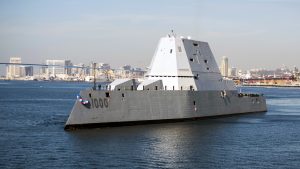Last week, the U.S. Navy accepted delivery of USS Zumwalt, the lead ship of the Zumwalt-class of next-generation destroyers. The delivery took place on April 24, the U.S. Navy noted in a statement published April 27.
“Delivery is an important milestone for the Navy, as DDG 1000 continues more advanced at-sea testing of the Zumwalt combat system,” Capt. Kevin Smith, program manager for the Zumwalt, said in a statement.
“The combat test team, consisting of the DDG 1000 sailors, Raytheon engineers, and Navy field activity teams, have worked diligently to get USS Zumwalt ready for more complex, multi-mission at-sea testing. I am excited to begin demonstrating the performance of this incredible ship,” Capt. Smith added.
After the delivery, the Zumwalt will transition to integrated at-sea testing, which will include development testing. The ship has now completed its combat systems activation, the Navy said.
The vessel was built by General Dynamics’ Bath Iron Works, with work concluding in May 2016. Raytheon Integrated Defense System built the vessel’s combat system. The Zumwalt-class is designed to serve as a multi-mission stealth vessel; due to cost overruns, the U.S. Navy will be procuring just three vessels of the class down from an initial plan for 32 vessels.
Each Zumwalt-class vessel will be armed with 20 MK57 Vertical Launch System (VLS) modules, with four launch cells per module. This would allow each vessel to use a range of VLS-compatible armaments, including RIM-162 Evolved Sea Sparrow Missiles, Tomahawk land attack cruise missiles, and the ASROC anti-submarine missile.
USS Zumwalt will displace 15,995 tons. With a length of 190 meters and a beat of 24.6 meters, the Zumwalt-class is significantly larger than the Arleigh Burke-class guided missile destroyers. The U.S. Navy is still building additional Arleigh Burke-class vessels after the cancellation of the originally envisioned Zumwalt fleet.
“Every day the ship is at sea, the officers and crew learn more about her capability, and can immediately inform the continued development of tactics, techniques, and procedures to not only integrate Zumwalt into the fleet, but to advance the Navy’s understanding of operations with a stealth destroyer,“ Capt. Andrew Carlson, the Commanding Officer of USS Zumwalt, said in a statement.
“After sailing over 9000 miles and 100 days at sea in 2019, we are absolutely looking forward to more aggressive at-sea testing and validation of the combat systems leading to achievement of initial operational capability.”
USS Zumwalt will be homeported in San Diego, the headquarters of the U.S. Pacific Fleet. It is assigned to the U.S. Pacific Fleet’s Surface Development Squadron One.

































